40 Years Field Research Laboratory in Togo
The
Institute of Tropical Medicine in Tübingen (ITM) is proud to celebrate 40 years of work in its Field Research Laboratory in Togo, West Africa.
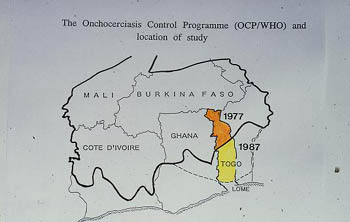
Togo and the Onchocerciasis Control Programme (OCP)
The presence of this field station is the continuation of a long lasting tradition of German physicians and scientists being active in the former
German colony. In 1884, the imperatorial attorney Mr Nachtigal signed a protection treaty with King Mlapa II. of Togoville, which ended at the beginning
of World War I after the capitulation of the German armed forces in Togo in 1915. After Togo’s independence from French colonial rule, which lasted
until 1960, German cooperation and engagement in Togo revived with several development programs.
In 1967 a National Institute of Hygiene was founded in the capital Lomé, the “Institut-Ernst-Rodenwaldt”, which since then has a central role
in health care, disease control and health surveillance in Togo.
In 1978 the Onchocerciasis Reference Laboratory (ORL) was inaugurated at the Institute of Hygiene with support from the
WHO and the
Gesellschaft für Technische Zusammenarbeit (gtz) under the supervision of Hartwig Schulz-Key - at this time collaborator at the
Tropical Institute Hamburg. After
1981 the scientific supervision of the ORL changed with him to the ITM in Tübingen. Due to the close collaboration with the
Onchocerciasis Control Programme (OCP), the Onchocerciasis Reference Laboratory
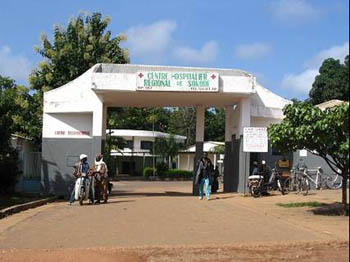
Centre Hospitalier Régional in Sokodé
was transferred, mainly based on epidemiological reasons, to the central region of Togo to the Centre Hospitalier Regionale (CHR) in Sokodé.
In Togo many human parasite infections are endemic. Since the beginning scientific emphasis of the ORL was to study the infection with the
nematode Onchocerca volvulus, a filarial parasite, which can be found in humans in subcutaneous connective tissue nodules. Its larvae, the
microfilariae migrate through the skin, during chronic infection also into the anterior chamber of the eye. Microfilariae are responsible for
the severe medical problems during infection. Microfilariae may cause dermatitis and sometimes irreversible eye damage up to the point of blindness.
The transmission of the parasite from human to human is through black flies (Simuliidae) which breed in fast flowing rivers and blood feed on their
human hosts living next to those rivers. During blood feeding on infected humans, black flies may take up microfilariae and with their next blood
meal will transfer infective larvae of Onchocerca volvulus to other man. Human settlings along rivers are especially exposed - there, 80% and more
of the inhabitants can be infected. Due to these characteristics onchocerciasis is also called “River Blindness”.
Once 10% of the village population has become blind, the settlings´ social structure gradually collapse, and young men being the first to leave the
village. Blind persons, women, children and the elderly stay in the beginning, until daily life activities come to a halt and the village is abandoned.
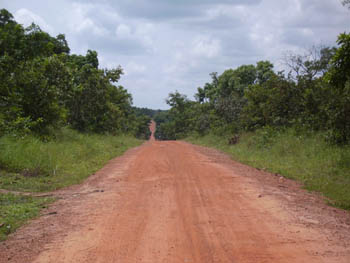
Road in the "Région Centrale"
Especially in the savannah, where people strongly depend on the water resources from rivers, onchocerciasis was, according to WHO, the most important
if not the only reason for the lack of successful agricultural activities and development close to rivers.
In its first years the ORL focused on epidemiological and parasitological studies of onchocerciasis in the south of Togo. With the development of the
collagenase-technique it became possible to isolate the fragile adult worm of O. volvulus from the connective tissue nodules after a nodule-ectomy, making
the adult worm accessible for morphological, biological, biochemical, immunological and chemotherapeutical studies. This technique made it possible to track
and to verify the breakdown of the adult worm population in the West African Savannah over years. This was achieved by the Onchocerciasis Control
Programme, which successfully interrupted transmission of the parasite by controlling black fly vector populations. This successful programme was
financed by the World Bank; Germany as well sustained a considerable part over the years.
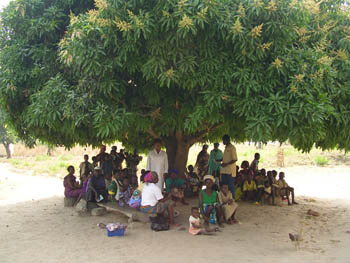
"Waiting room" in front of a dispensary
These investigations showed that the parasite has a life span of over 10 years. Until then drug treatment of onchocerciasis has been problematic and not
very successful. It was a major achievement when the ORL became integrated into the phase III and phase IV studies of the new antihelminthic drug Ivermectin.
Today, ivermectin therapy is applied with success in mass treatments against onchocerciasis. A single dose is highly effective against microfilariae in the skin,
but treatment has to be repeated every year, because adult worms in the nodules will not be affected by ivermectin. The adult worms of O. volvulus will
exert immune suppressive effects in their human host, this is to assure survival and transmission of the progeny, the microfilariae. This immune defect
is gradually reverted after the treatment with Ivermectin, and the immune system is step by step able to eliminate the newly born mikrofilariae by itself.
This phenomenon named “ivermectin-facilitated immunity” was and still is object of research of Peter Soboslay and collaborators. Since the late eighties
research activities in the laboratory expanded, particularly by immunological studies and Public Health aspects.
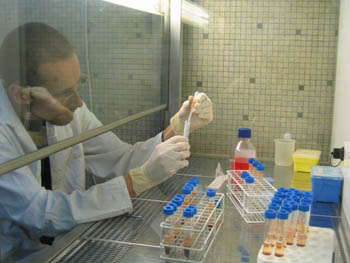
Onchocerciasis Reference Laboratory "Projet Oncho"
The ORL has become a popular facility for students of biology and medicine, where up to now almost 100 could finish their master- or PhD-thesis. Next
to the question, how infections with one or more parasites may affect the immune response of the host, the impact and the consequences of prenatal immune
priming and the influence of parasite infections on allergies or on physical and cognitive development in children have been and are still subjects of
investigations. The laboratory is closely attached with national health projects and collaborates closely with the Ministry of Health and local and regional
authorities.
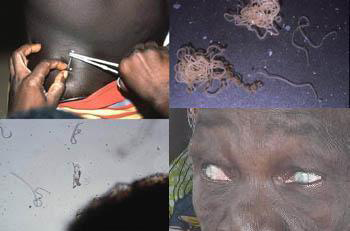 Onchocerca volvulus
Onchocerca volvulus and Onchocerciasis
The parasite O. volvulus is strictly host specific. For experimental studies one depends on filariae in other hosts, of which a few develop in rodents
and serve as a model for human infections. In this field it is Wolfgang Hoffmann, who has found a nearly ideal model for filarial infections. In Tübingen
he emphasizes on questions of resistance and susceptibility, the studies being integrated in the
National Genome Research Network (NGFN). In addition, the
experimental parasite-host models are suitable to study the effect of parasite helminth infections on allergy and other acute and chronic inflammatory disorders.
The work of the research laboratory in Togo was regularly funded by third parties, e.g. the
gtz, EU,
WHO,
Edna McConnell Clark Foundation,
DFG and by the
Landesstiftung Baden-Württemberg. Generous support was provided by the
Medical Faculty of the University of Tübingen as well, obtained through research
programmes like fortune, IZKF and the Prof. Dr. Stingl Afrika Fond.
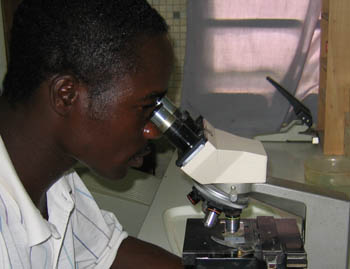
Laboratory Diagnosis
Field stations are of great importance for the North-South dialogue, and as emphasized and declared by the

Cooperations "Projet ONCHO"
German President Horst Köhler in his
World-Ethos-Speech in Tübingen, the African continent
and its unsolved problems are at his personal concern and demand heightened initiatives.
Furthermore, the education of students in parasitology and tropical medicine, as successfully practiced by the ITM Tübingen, is highly relevant for a
thoroughly qualifying professional education. This is a challenge which demands from the young students, and also their mentors, enthusiasm and
initiative, and a lot of idealism as well.
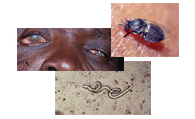

 Togo and the Onchocerciasis Control Programme (OCP)
Togo and the Onchocerciasis Control Programme (OCP)
 Centre Hospitalier Régional in Sokodé
Centre Hospitalier Régional in Sokodé
 Road in the "Région Centrale"
Road in the "Région Centrale"
 "Waiting room" in front of a dispensary
"Waiting room" in front of a dispensary
 Onchocerciasis Reference Laboratory "Projet Oncho"
Onchocerciasis Reference Laboratory "Projet Oncho"
 Onchocerca volvulus and Onchocerciasis
Onchocerca volvulus and Onchocerciasis
 Laboratory Diagnosis
Laboratory Diagnosis
 Cooperations "Projet ONCHO"
Cooperations "Projet ONCHO"